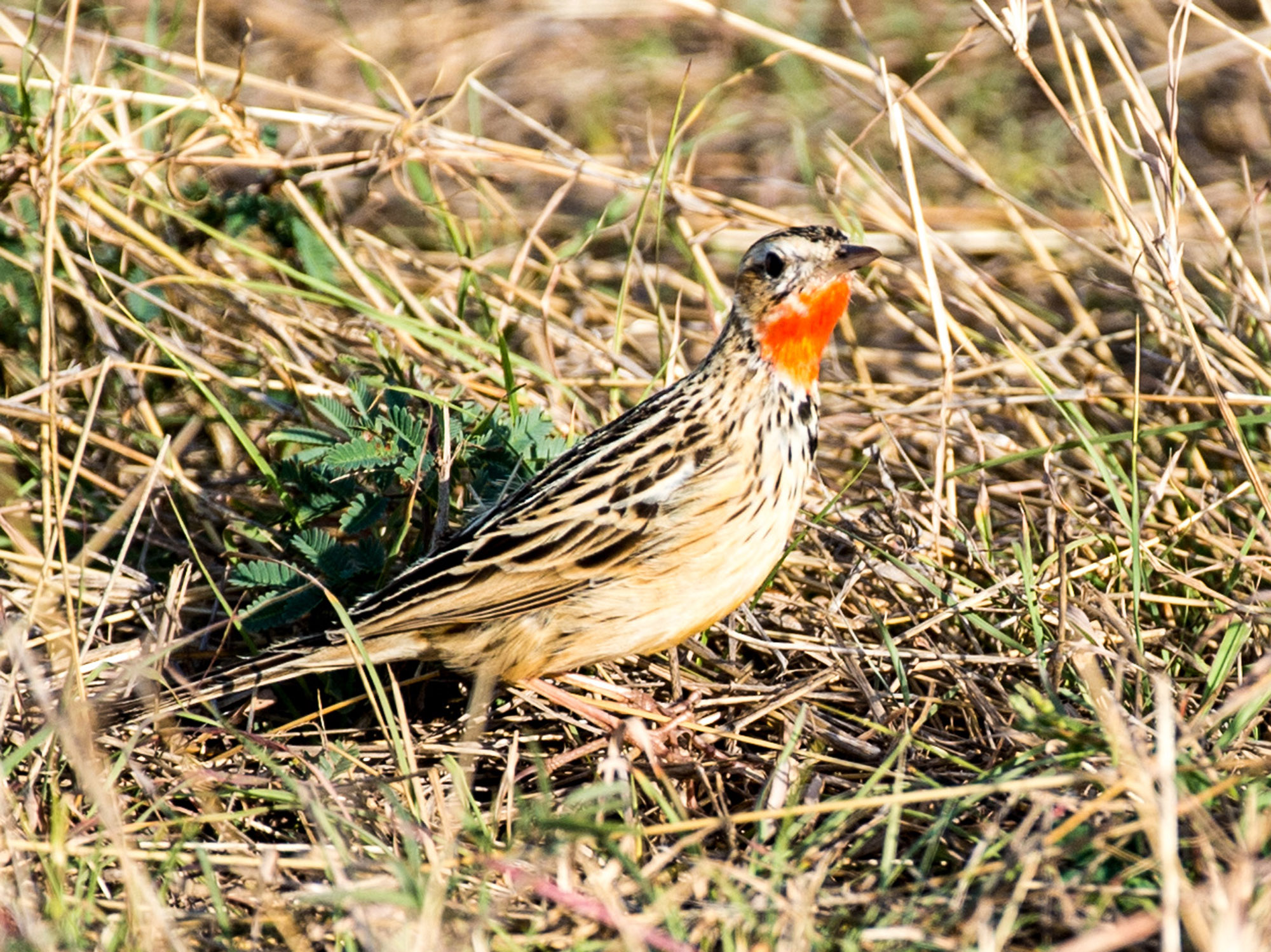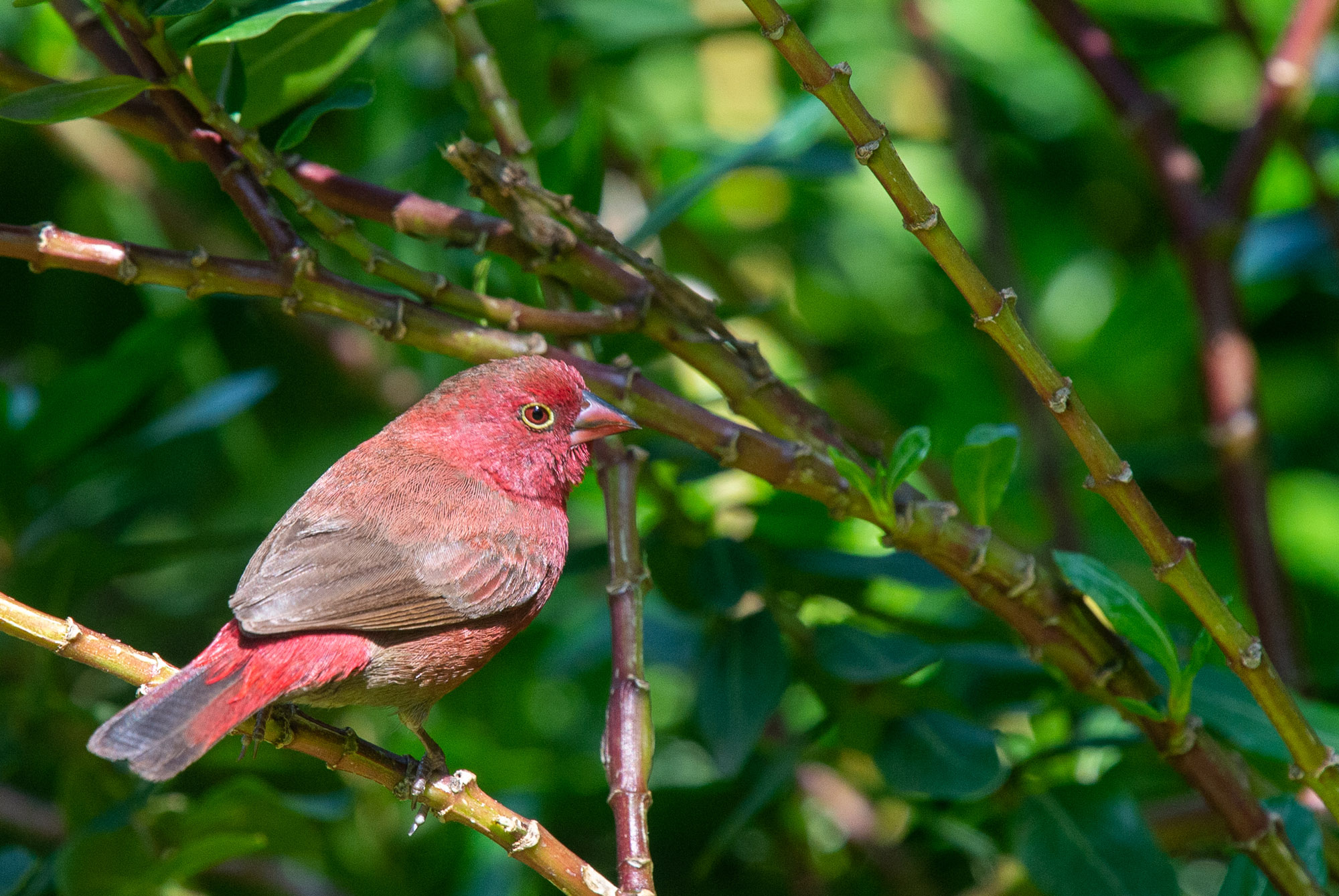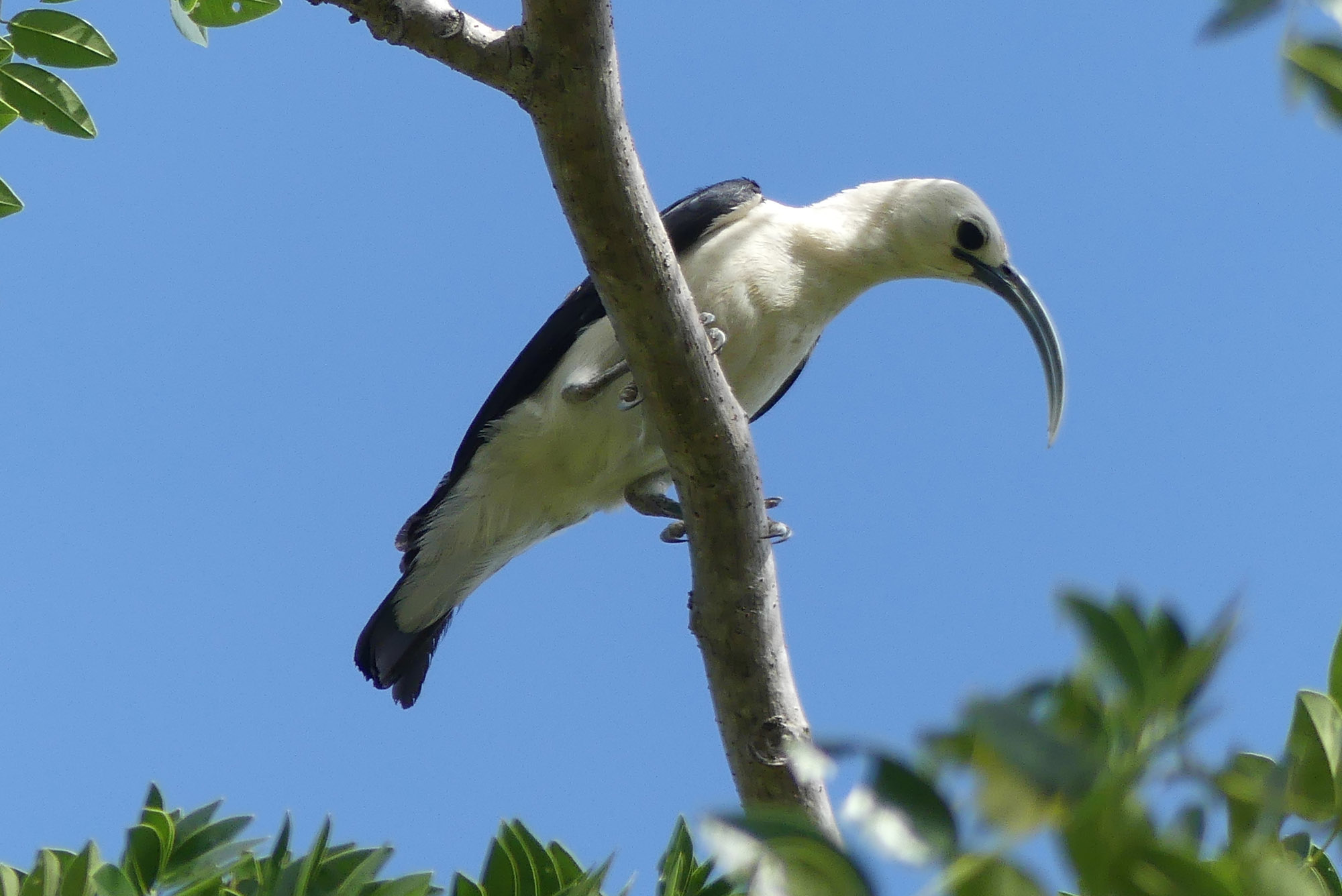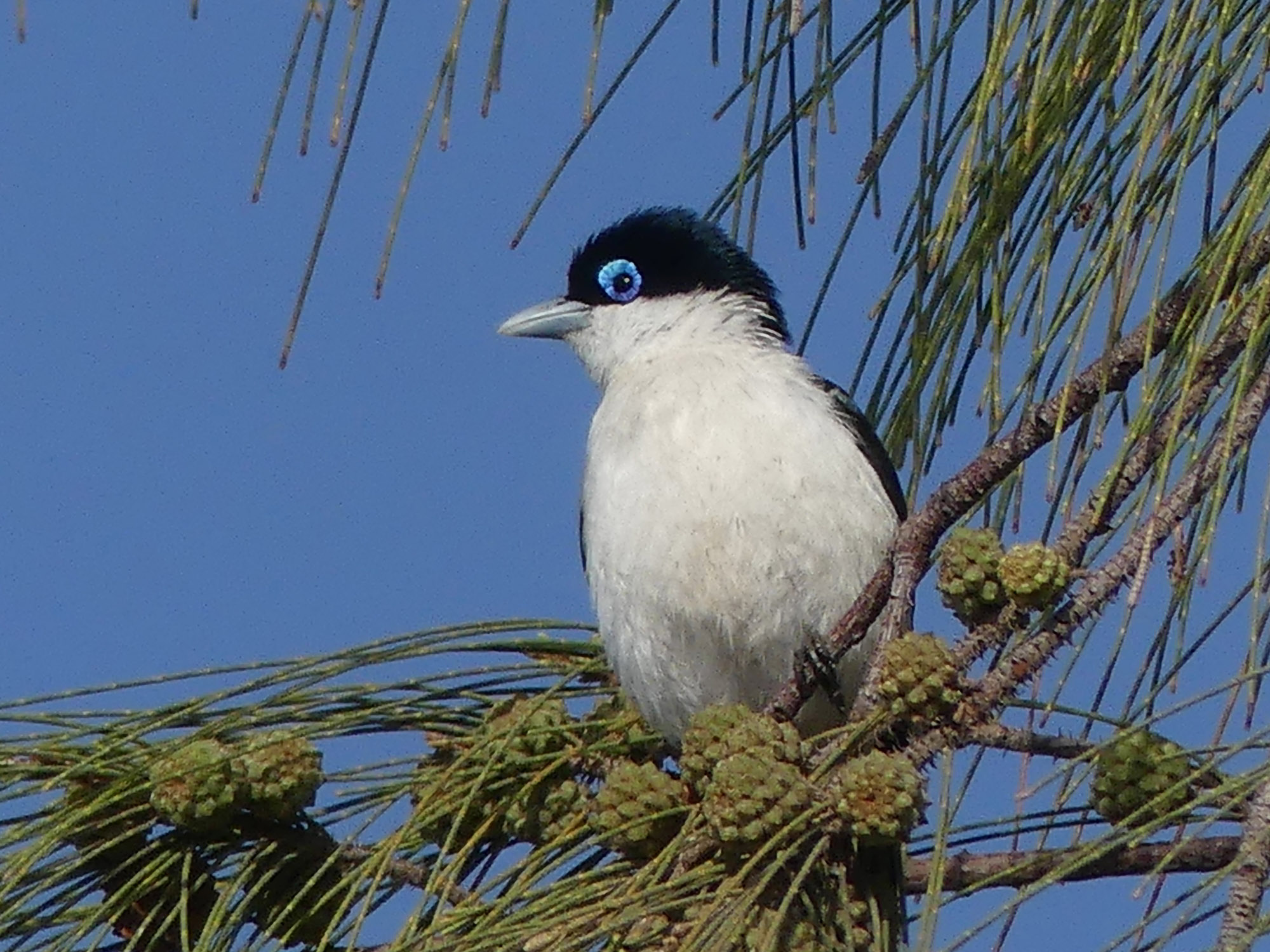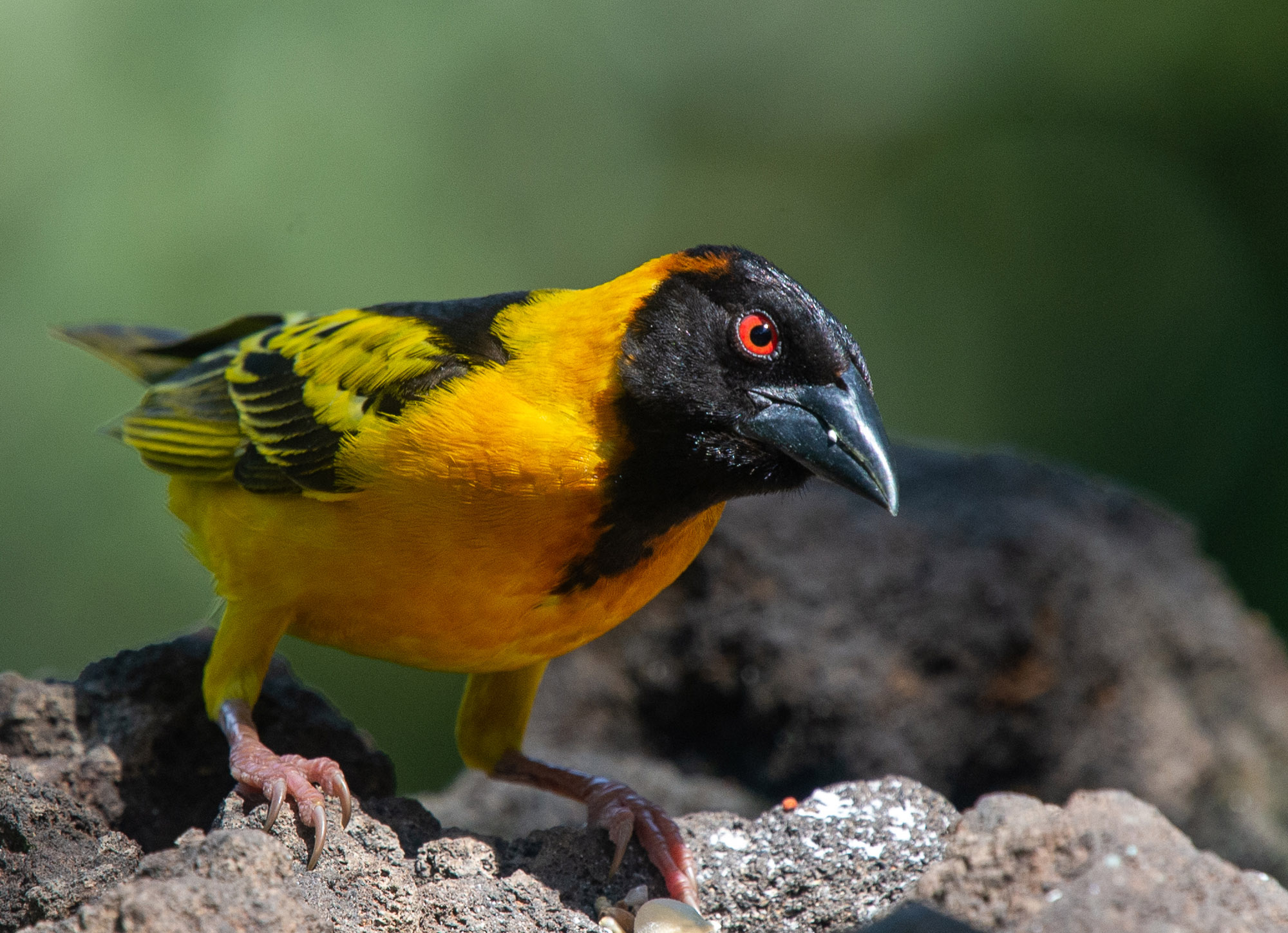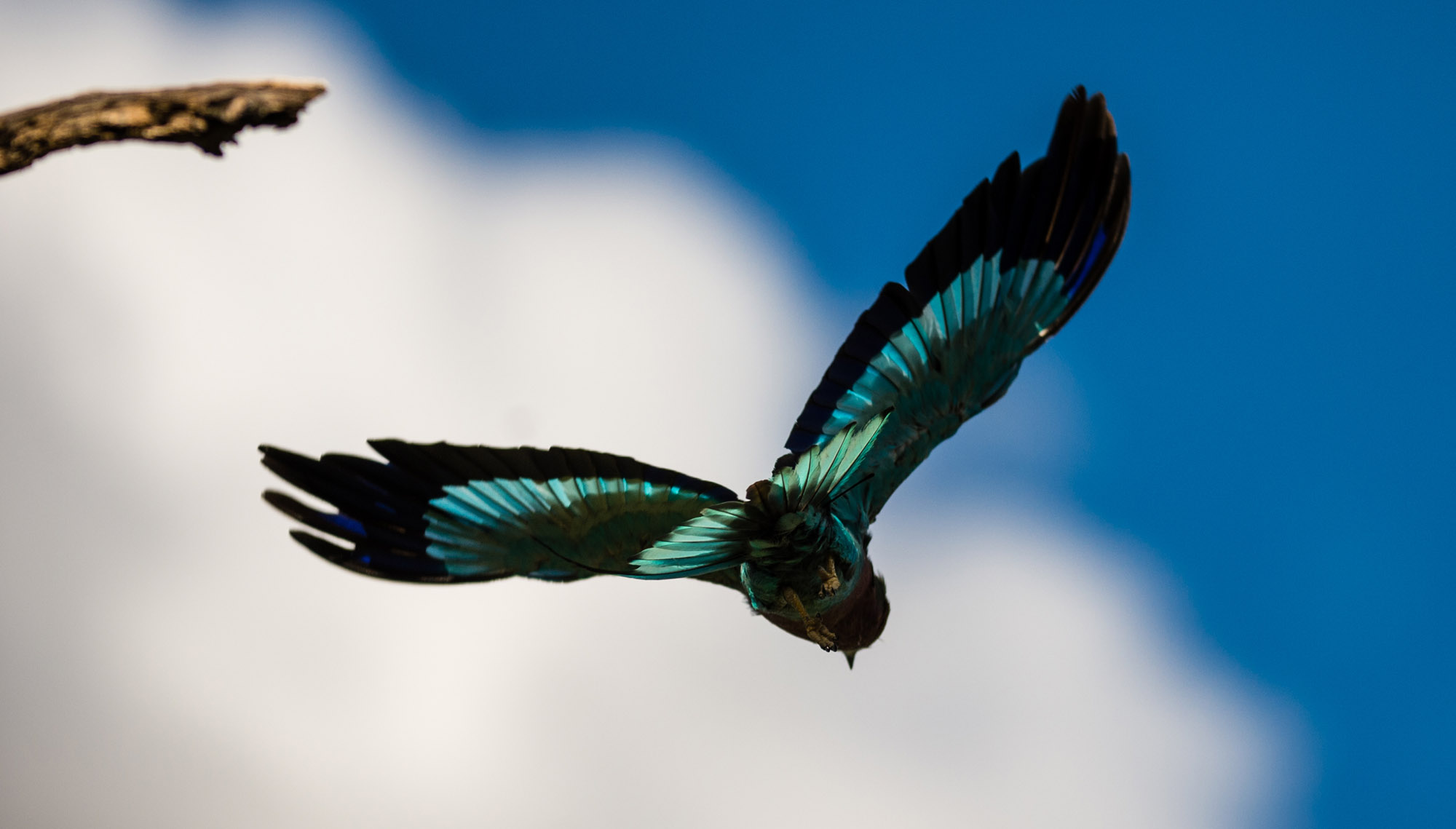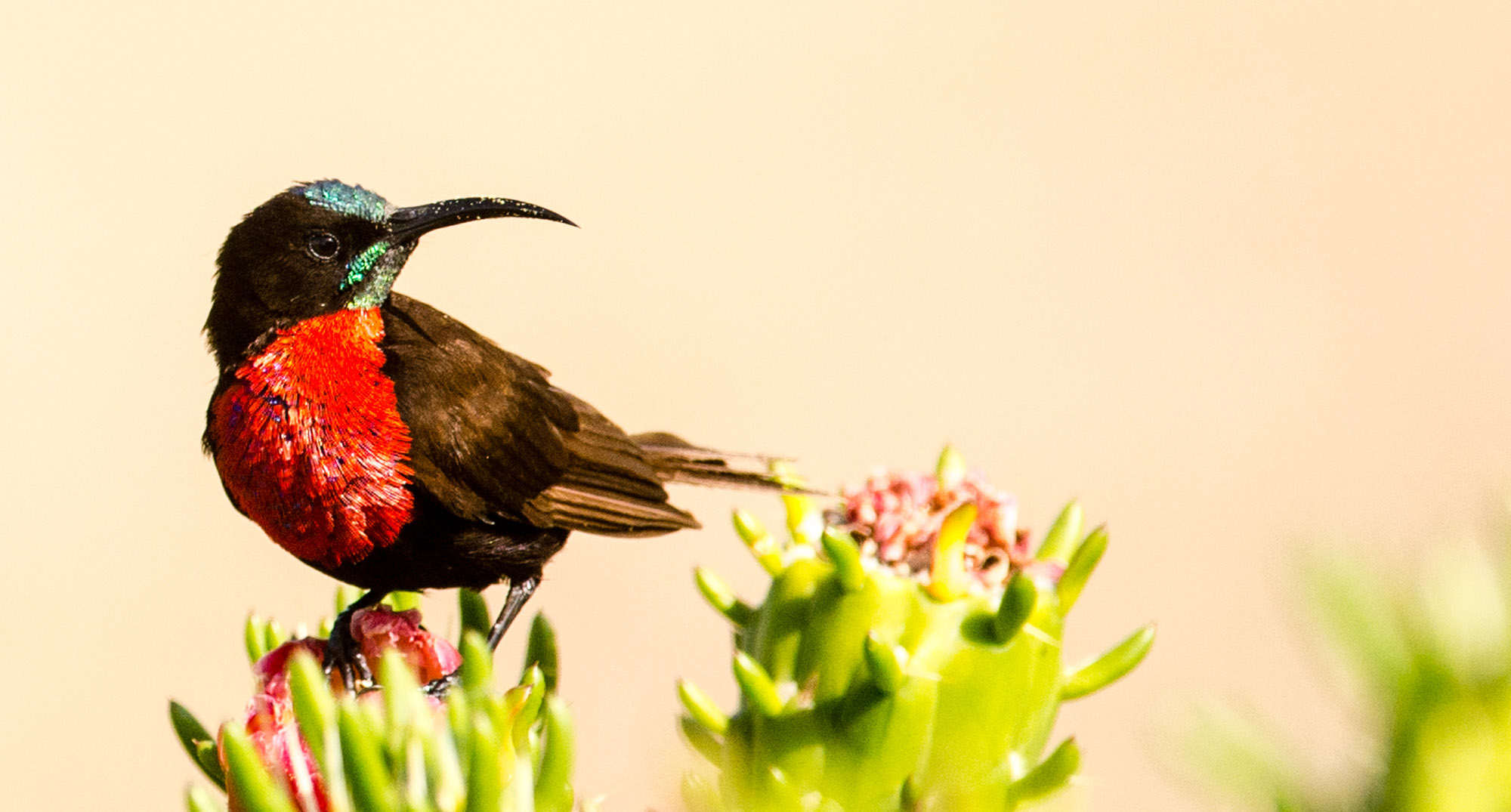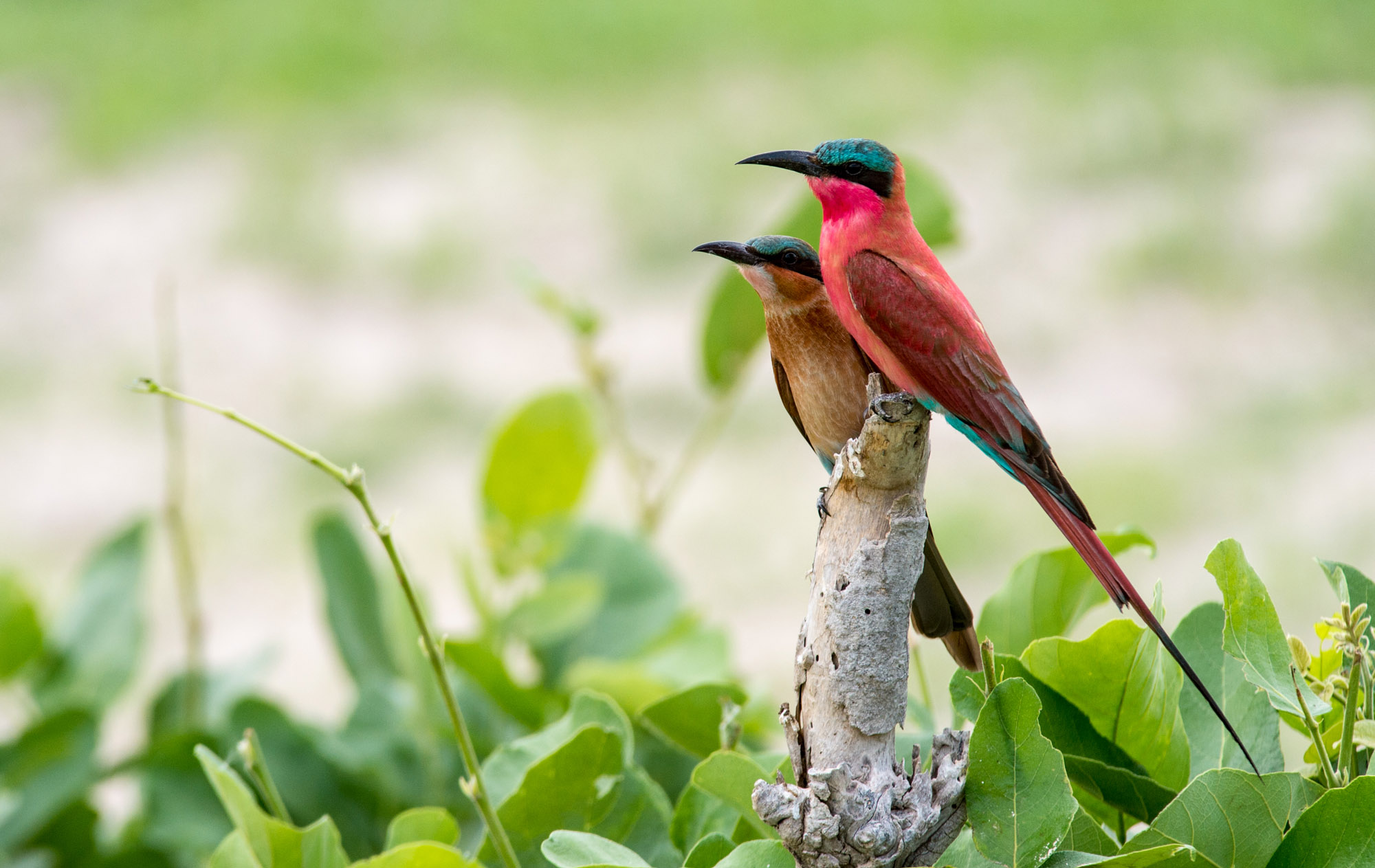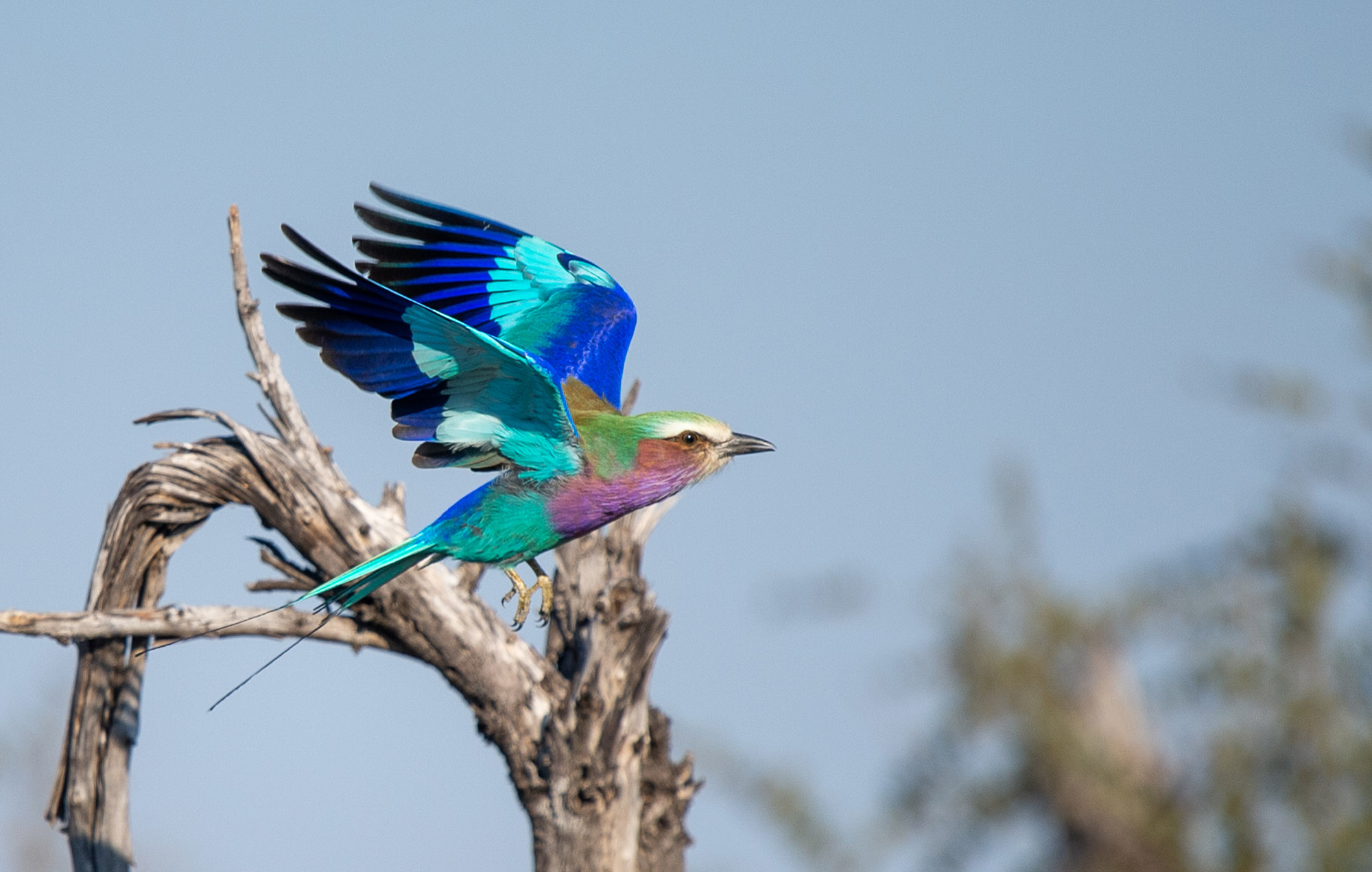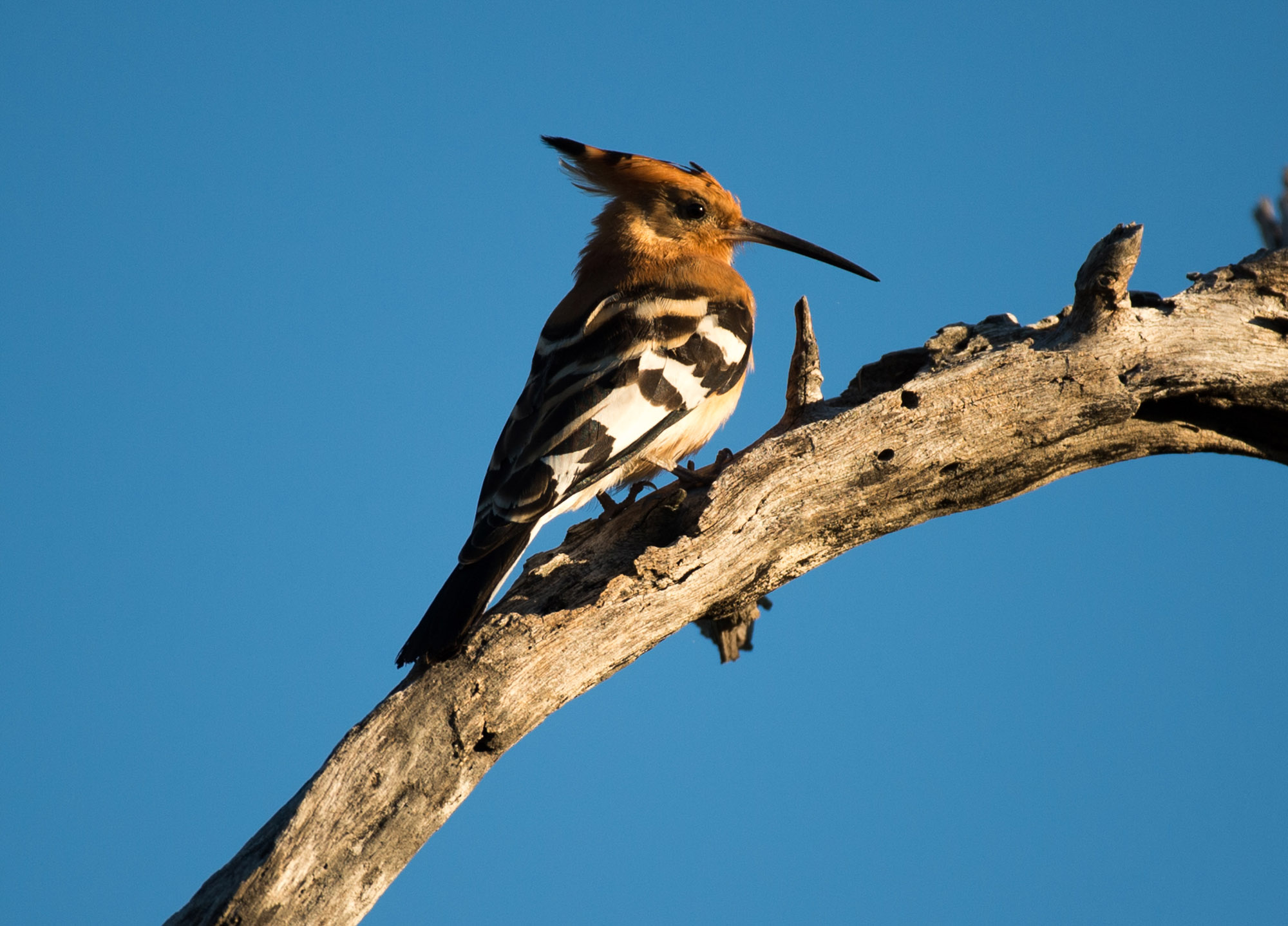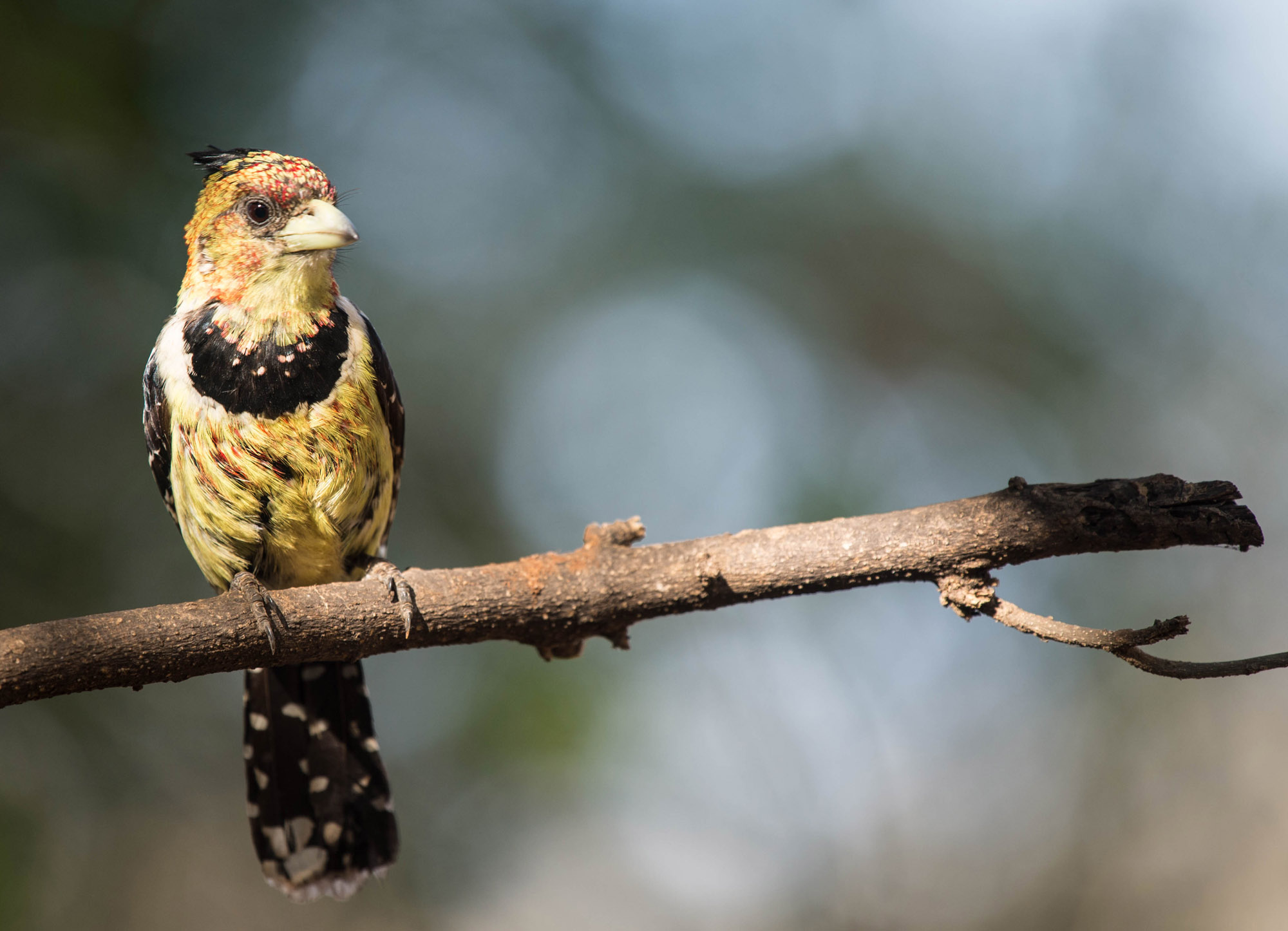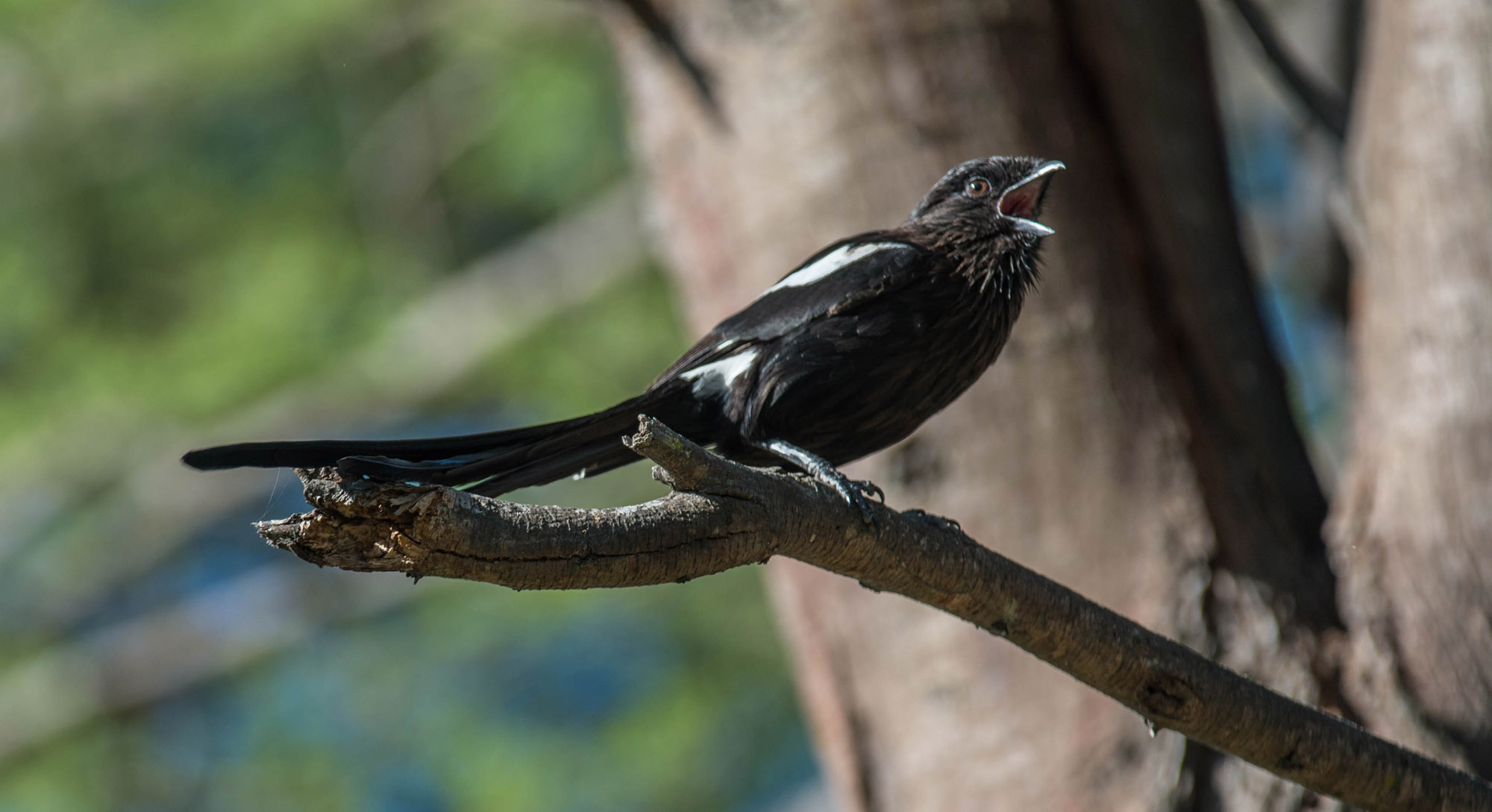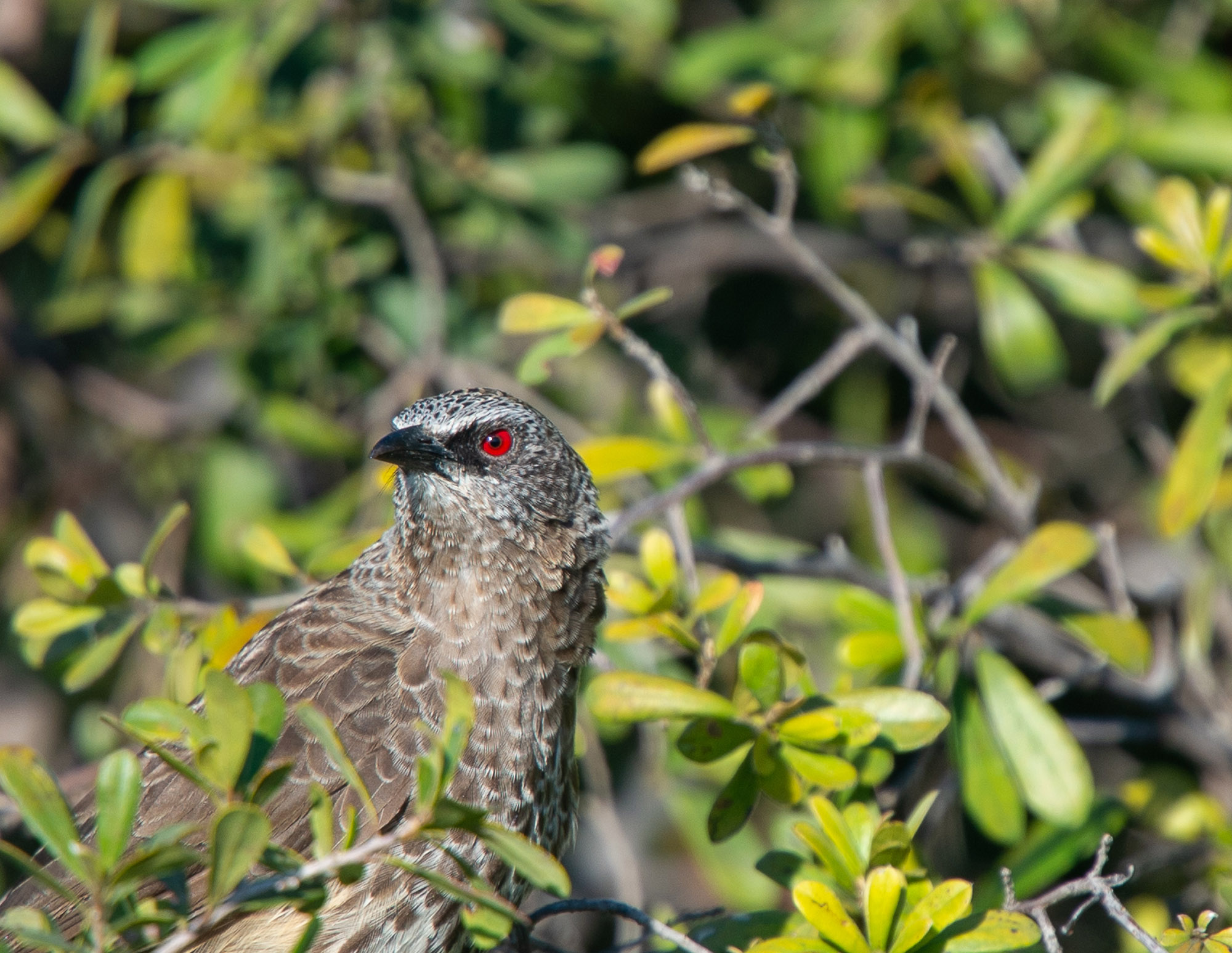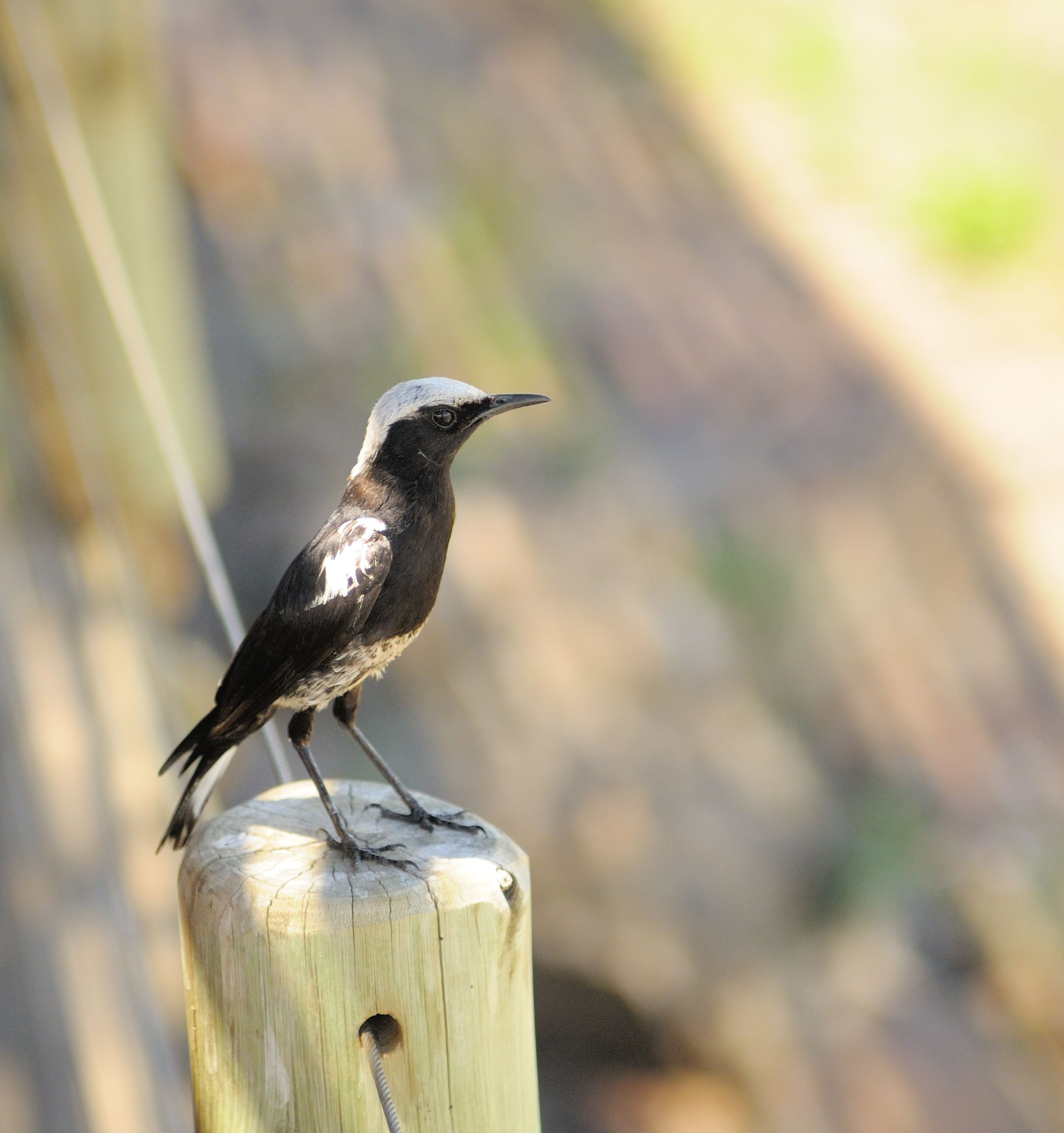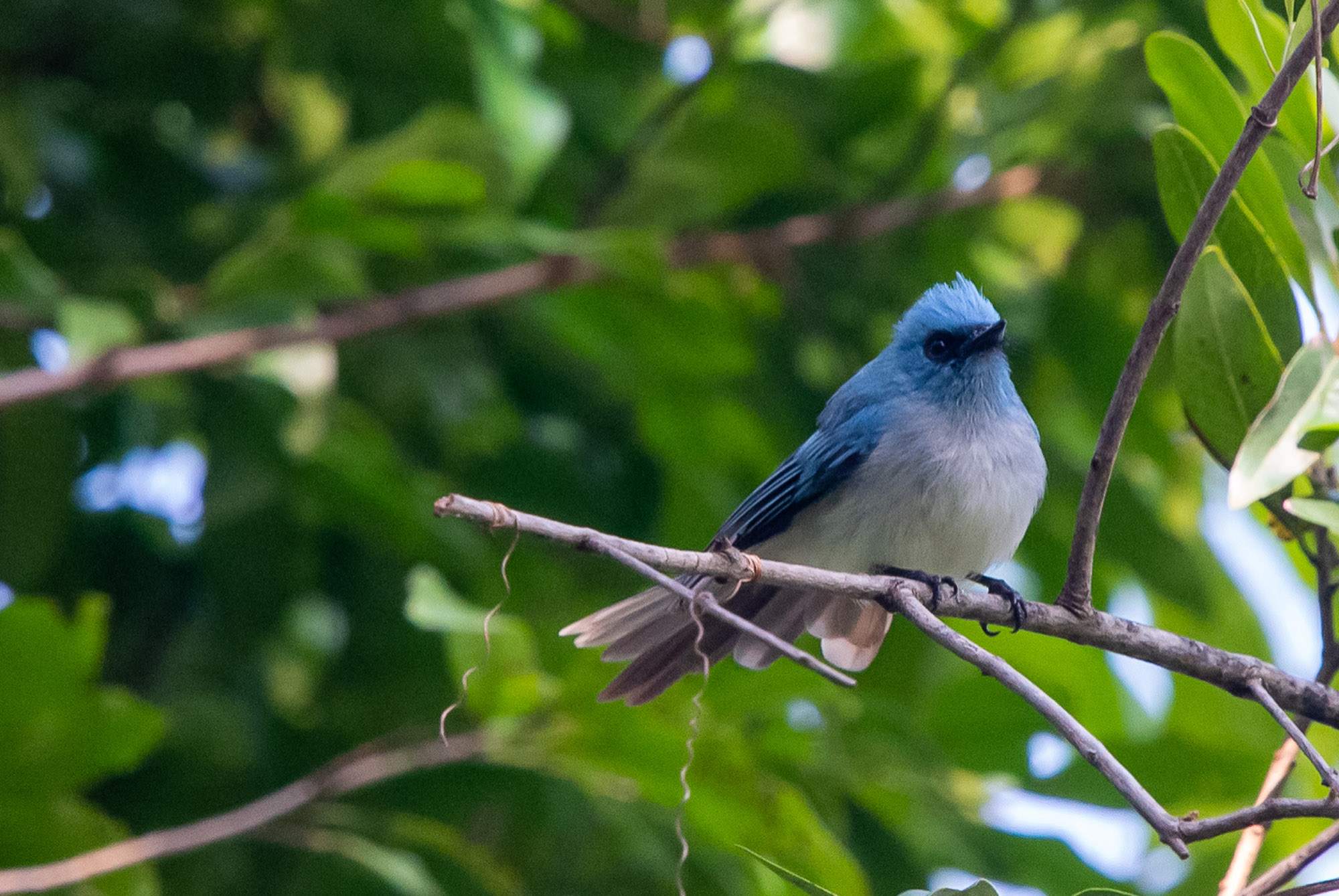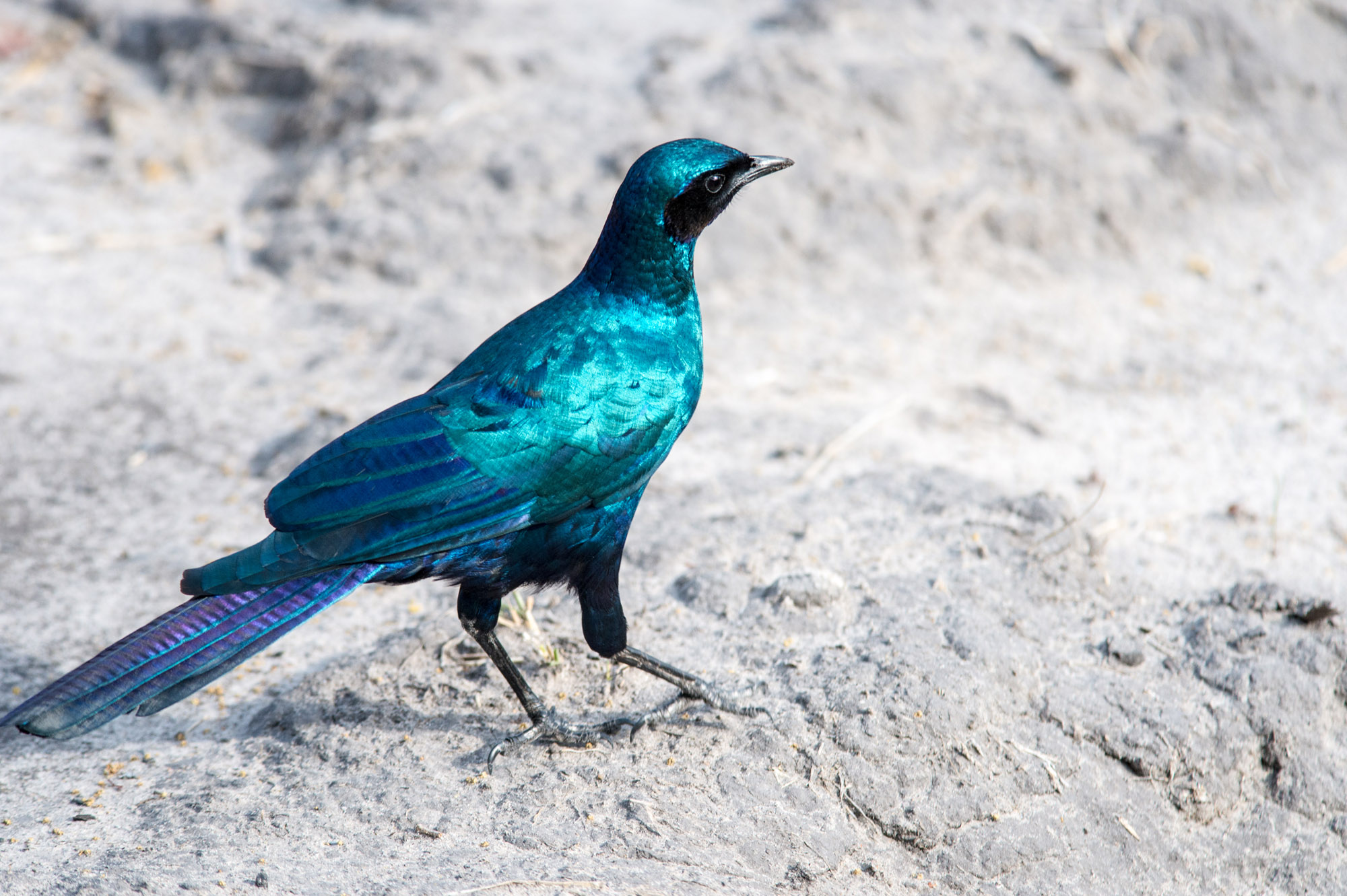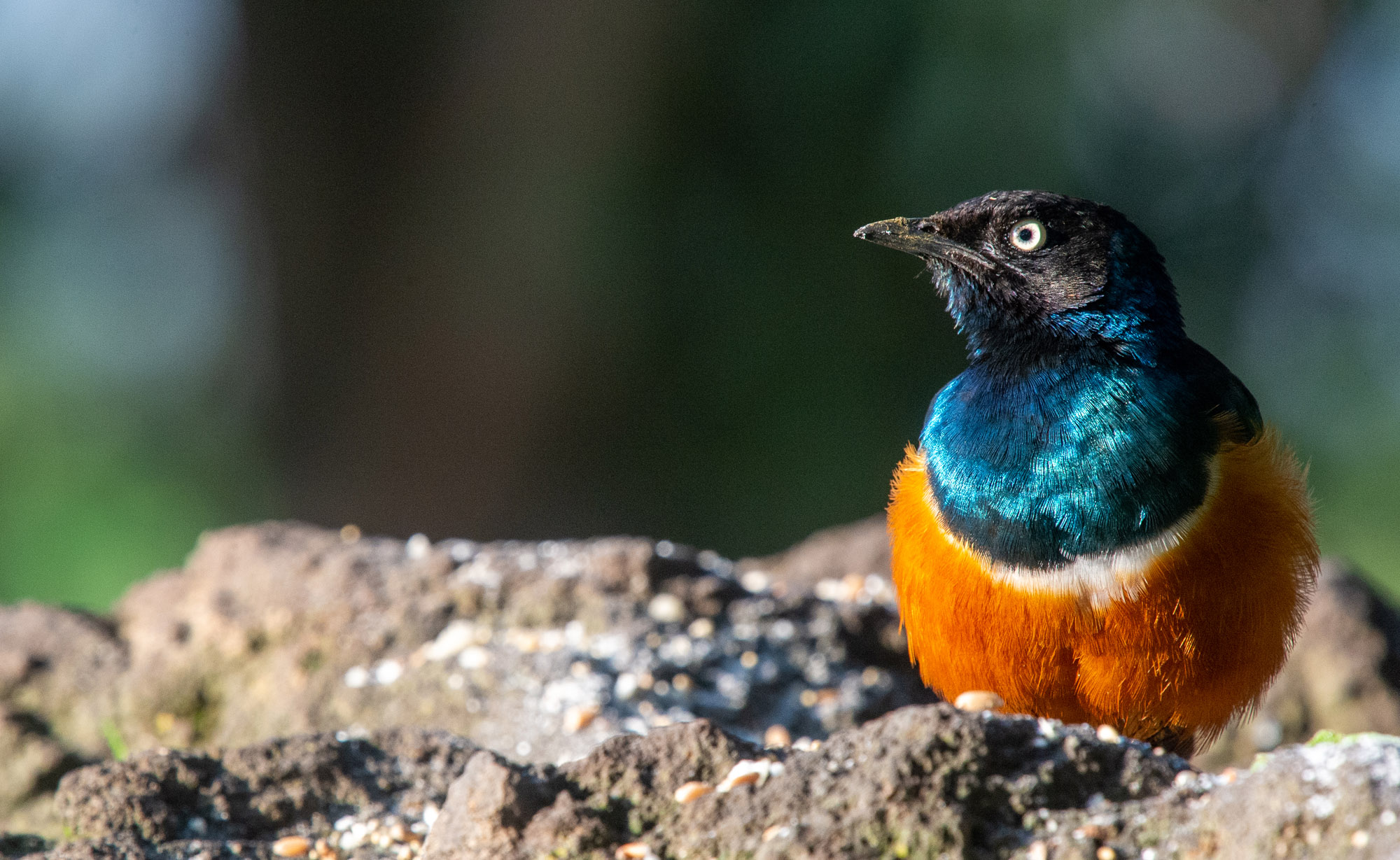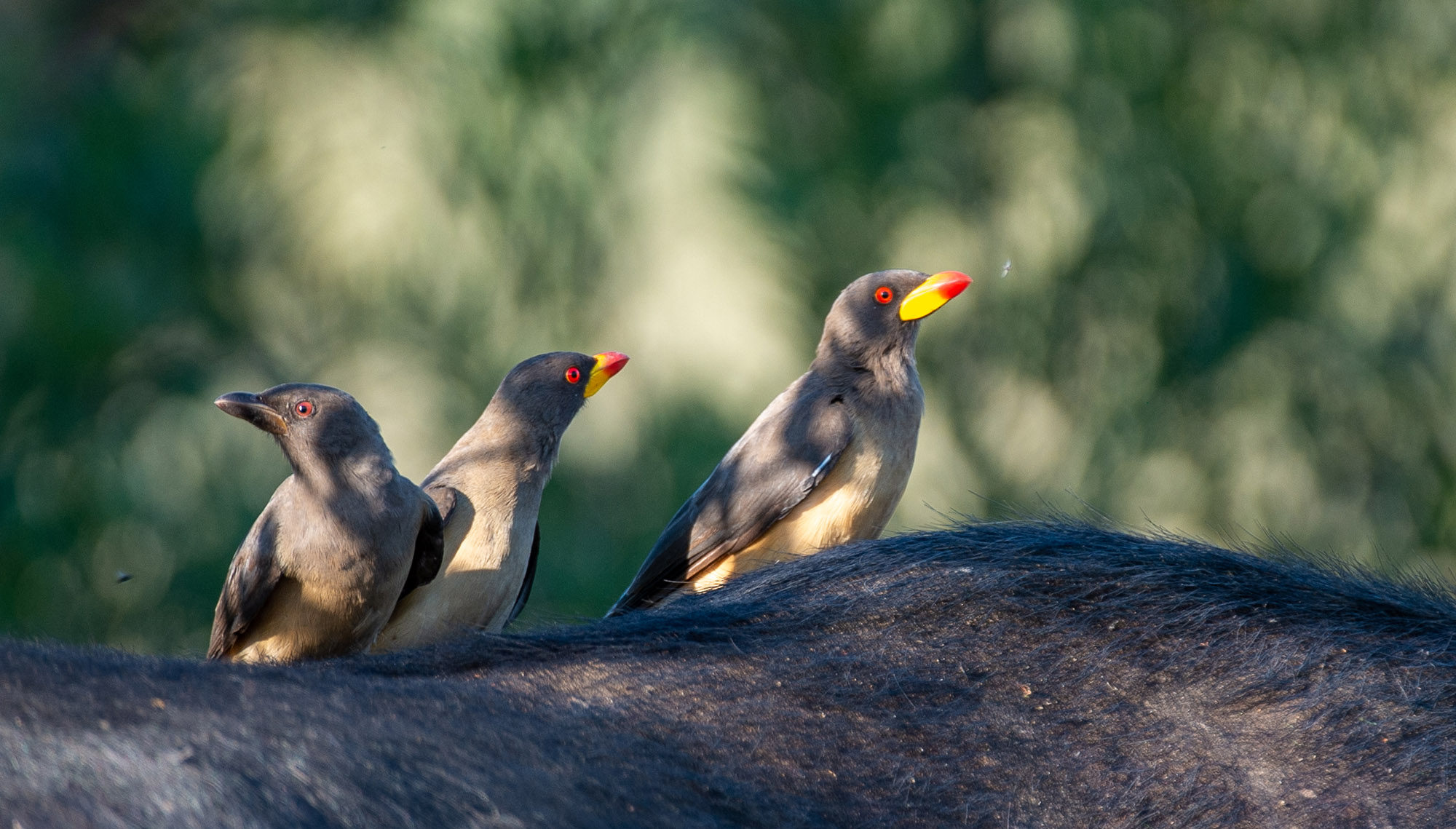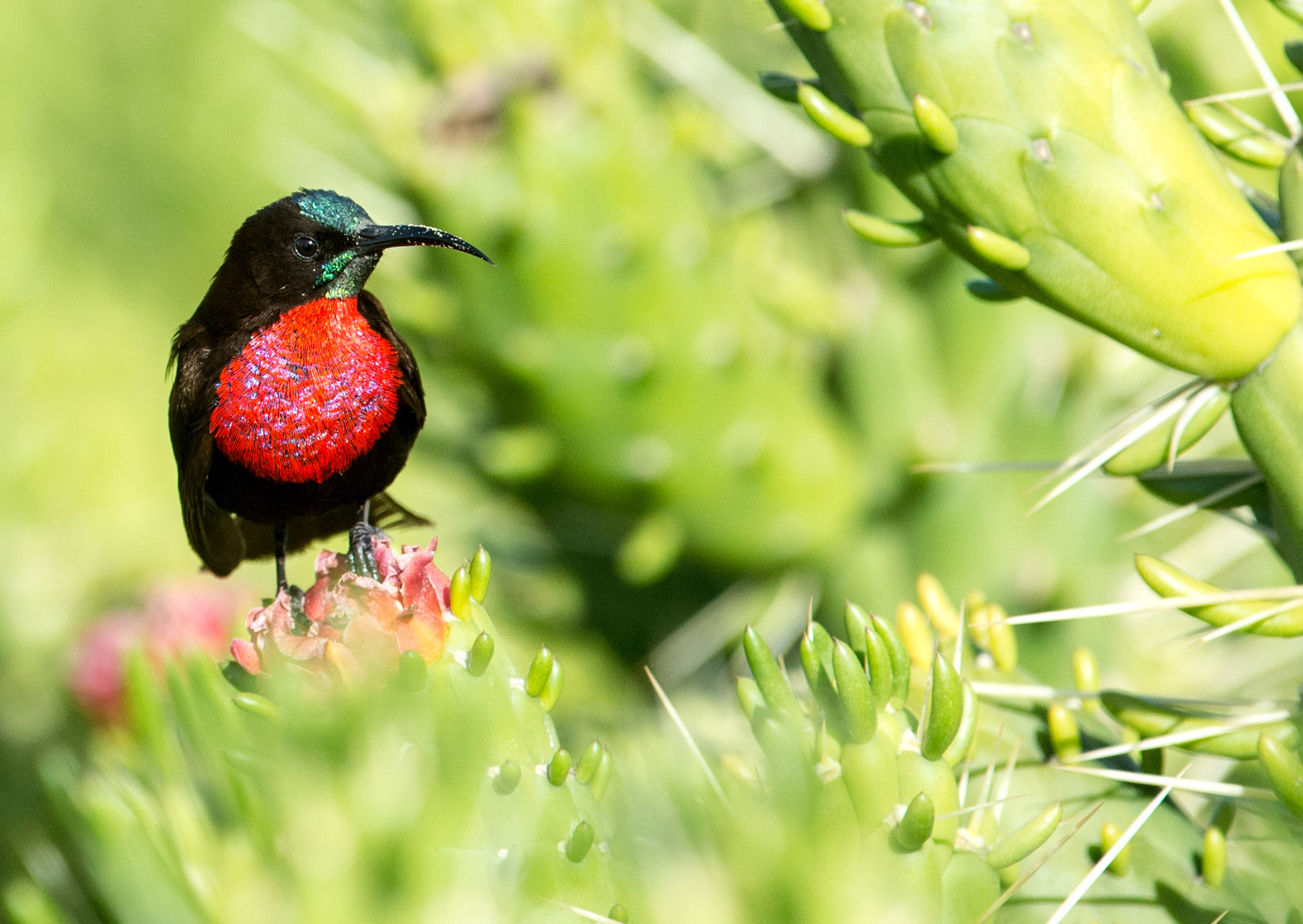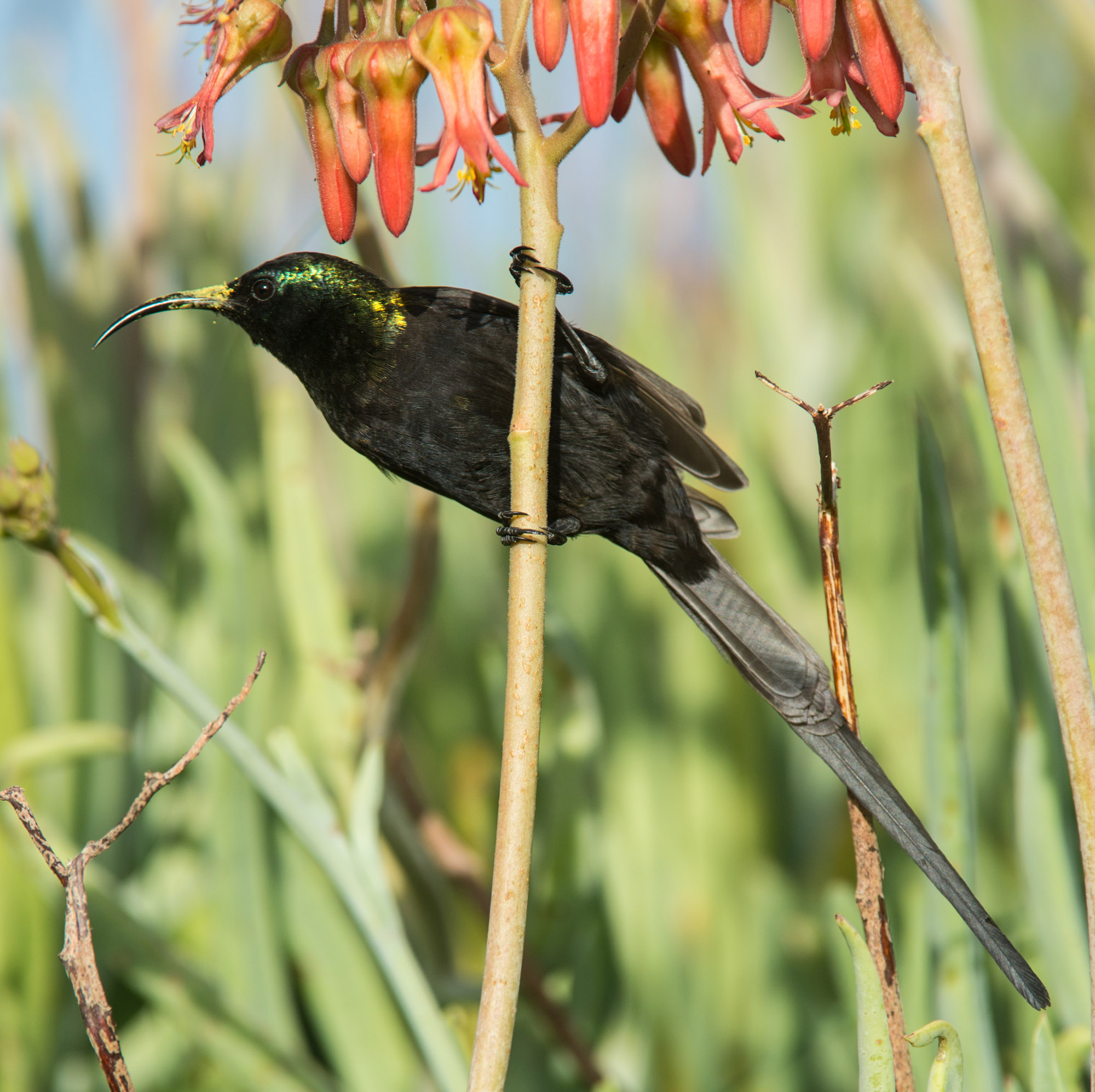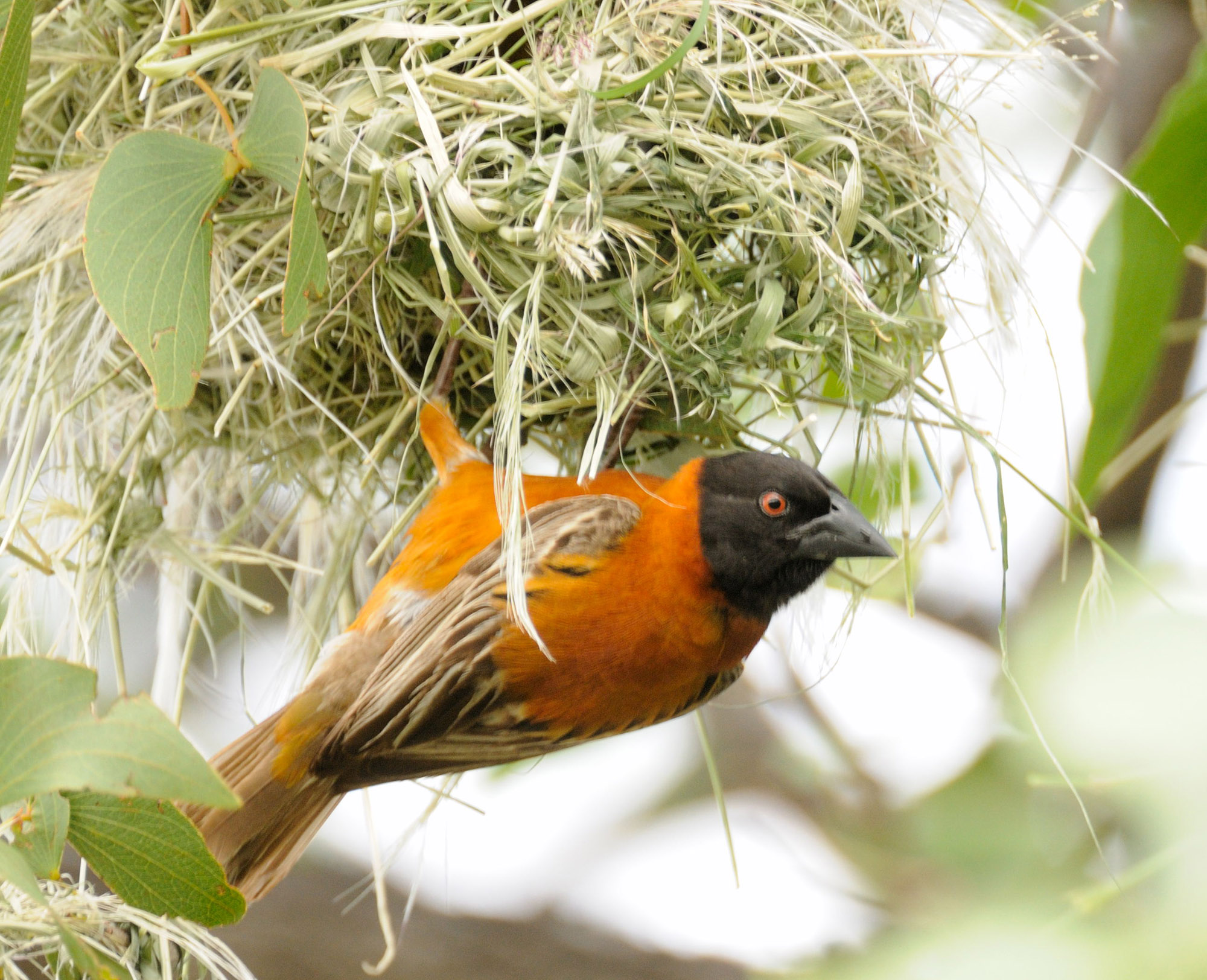Beautiful Birds of Africa: Part 3
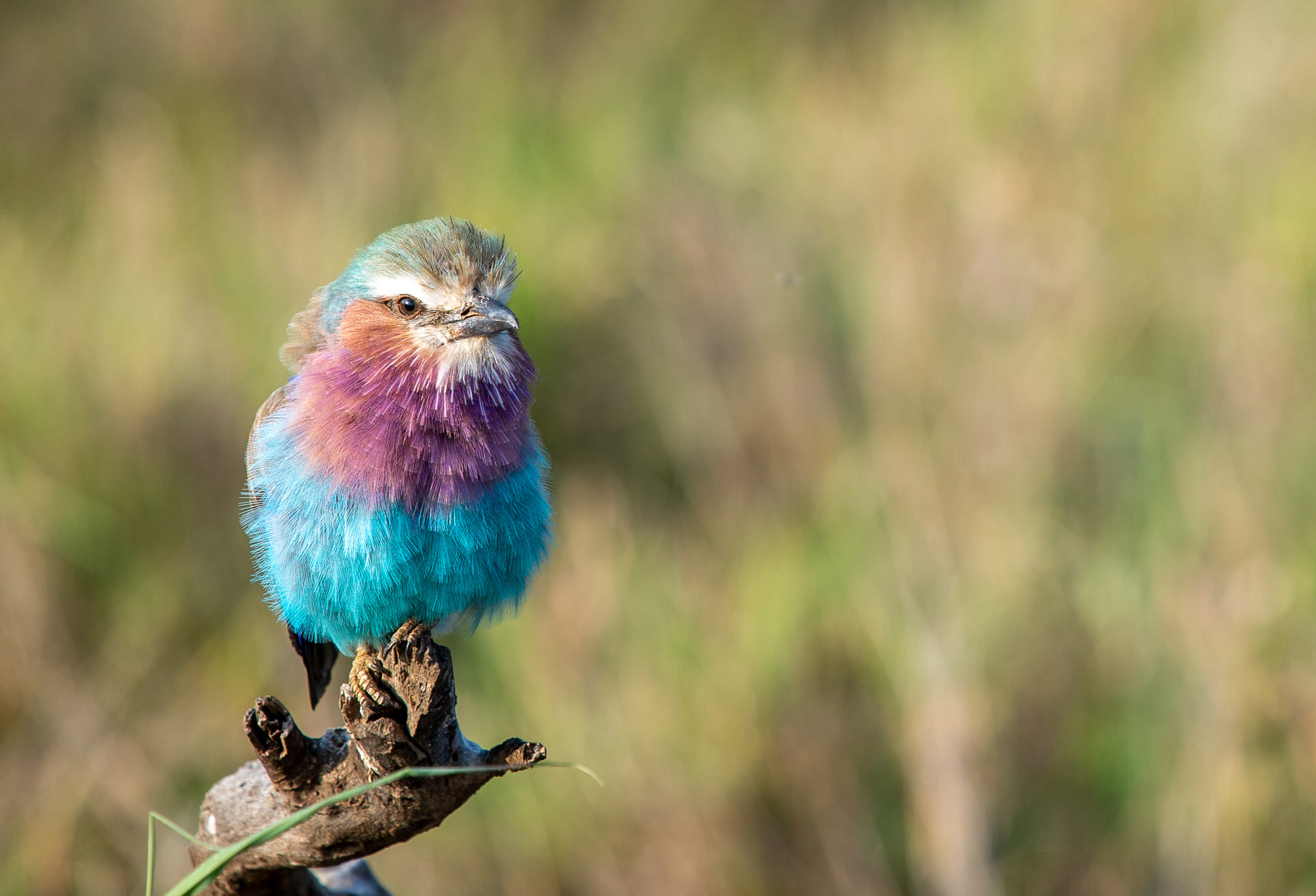
Beautiful Birds of Africa: Part 3
Traveling through Africa, no matter where you find yourself, you will soon learn that birds are to be found in even the most inhospitable of habitats, such as the Namib Desert. Birds like the cryptically colored, ground-dwelling Dune Lark and Gray’s Lark, which somehow manage to exist in the gravel plains of the Namib, where surface temperatures may exceed 45C (113F) during the heat of the day. Just like humans, birds are supremely adaptable and have evolved, over millennia, to be able to thrive under what may appear to be impossible conditions.
What is even more remarkable to me is how one bird can adapt to look and act just like another completely unrelated bird, found in a different part of the world, as a result of an evolutionary pattern called convergence. When I first saw a Western Meadowlark here in Texas, for example, I looked at my birding companion and said, ‘Nice, we’ve got those in South Africa too. A Yellowthroated Longclaw, right?” His face took on a perplexed look. “A what? Longclaw? No man, that is an Eastern Meadowlark.” This happens when two separate species evolve similarly, because they find themselves in similar environments.
Despite occurring in different parts of the world, with some 8,000 miles separating them, meadowlarks and longclaws ended up being practically identical, superficially. The exact same yellow and black plumage pattern, general shape and size and even behavior, with a characteric low flight and trilling wings. The birds ended up being peas in a pod, despite not having any common ancestors for millions of years, because their plumage and behavior best enable them to blend in, survive and thrive in a grassland environment.
The opposite evolutionary pattern – divergence – when one species separates into two and then develops individually, is perhaps better known and can be easily seen in nature as well. Such as in Madagascar.
If you’ve ever wondered what it must have felt like to be Darwin, walking around the Galapagos completing the Natural Selection puzzle, Madagascar will appeal to you. Spend a few days there and you cannot fail but see Darwin’s theory of evolution come alive in front of your very eyes. Look at a white-headed vanga and then – maybe just minutes later – observe a sickle-billed vanga fly by. Practically the identical bird except for a marked difference in bill adaptation. The one with a stout conical bill, the other one similar in general appearance and shape but with a massive decurved bill. Clearly adapted to probe crevices and holes for spiders and crickets and other insects. Evolution in its purest form. It is estimated that the sickle-billed vanga split from the white-headed vanga somewhat more than a million years ago.
If you do end up heading to Madagascar someday – and you’re interested in birds – do a little bit of homework. The island doesn’t have an inordinately high number of species, but every second species you see, will be endemic to the country. There are 22 vanga species, for starters. Each one markedly different from another. In fact, Madagascar’s vangas easily beat Darwin’s Galapagos finches for diversity. The same is true of the striking coua family; there are nine of these mostly terrestrial birds of the cuckoo family in Madagascar. Every single one found only there.
So when you do see the amazing variety and diversity of birds all over Africa – and perhaps Madagascar – you are looking at the culmination of millions of years of subtle, imperceptible change and adaptation. From the tiniest skulking Firefinch to the most fierce-looking Martial Eagle, every one of them looks and acts the way it does, as a result of the long evolutionary path they have been on since the last major extinction event, some 66 million years ago. Most dinosaurs went extinct. Mostly birds remained. Since then, birds have evolved in many ways, enabling them to survive in a multitude of habitats.
According to an article in Current Biology (May 2019), birds – dominated by seed-eaters – fared extremely well in resettling the vacated ecological niches, in the wake of the extinction event. In fact, they radiated to create a level of diversity unrivalled among terrestrial vertebrates. Scientists disagree on the exact reasons why birds have done so well, but clearly their relatively small size, the fact they can eat many different foods and their ability to fly, all played a part.
Having emerged from the last mass extinction much better than most species, birds are now facing several new man-made threats to their survival. Primary among these are loss of habitat and a precipitous decrease in the abundance of insects, worldwide. Climate change and the resultant global warming are also negatively impacting bird populations. Nobody knows which of them will be the survivors this time.
For now at least, there are more than 11,000 bird species in the world, of which about 2,300 species occur in Africa. More than 1,400 birds are endemic to Africa – found only there. Be sure to be on the lookout for them and if you are contemplating a first trip to Africa, make sure that you end up with a guide who is knowledgeable about birds. It literally opens up a whole new world to visitors of Africa’s wild places.
Bee-eaters and Rollers
Colorful and lively, Bee-eaters and rollers are among the most spectacular birds to be seen anywhere in Africa. Some of them like the Little Bee-eater, the Lilacbreasted Roller and the Carmine Bee-eater are celebrities of the world of birds, the object of attention whenever they are around, never far from glinting lenses and clattering shutters.
The Lilacbreasted Roller easily takes the cake for being the most dazzling of the true bushveld birds. They are attention hogs like few other birds, almost always perched on a twig or branch close to the road or trail, often not more than about 8 to 10 feet or so above the ground. Almost every visitor to sub-Saharan Africa will be able to get a half-decent photograph of a Lilac-breasted Roller. Perched. In flight? Now that’s the real challenge! In hundreds of attempts over the years, I have maybe a half dozen or so good LBR shots, showing them to their best advantage.
The trick is anticipating the moment at which they decide to take flight. Or better yet, the split second before that moment. Even when you guess correctly and have the camera clattering away the moment the bird spreads its wings to take off, all manner of things still go wrong. The #1 bad outcome? The roller dives down and away. Try again. Here’s a hint: set your camera on the Manual setting at f-8 with a shutter speed of 1,000th of a second or faster (when the light is good), with the ISO on automatic. Autofocus enabled.
Hoopoes, barbets and woodpeckers
The distinctive African Hoopoe is quite common but not always easily observed, due to its habit of flitting from one spot to the next in a seemingly haphazard, unpredictable manner, looking and acting just like a giant butterfly in the process. Observe it closely the next time you see one. When undisturbed, its characteristic crest is closed up, but when it is excited or agitated, the crest creates a little mini-fan on top of the Hoopoe’s head. These beautiful birds are common garden birds over much of Africa and are highly revered, to the point of being legally protected in many areas.
Africa is not particularly well endowed with woodpecker species, but in most woodland habitats you’re likely to come across a couple of species. Often heard before being seen, their characteristic tapping noise is a dead giveaway, as is their loud, piercing calls. Many African woodpeckers are basically golden brown above and paler below, with a bewildering variety of facial stripes, eyebrow lines and red, spotted or black caps, and breast patterns. It usually takes more than just one good view in a pair of binoculars, to positively identify them. The smallest woodpecker in Africa is the cardinal woodpecker, which is common everywhere except really arid areas.
In South Africa, the largest and most unusual woodpecker is the ground woodpecker. This mostly olive-grey bird with a pinkish belly and rump, is endemic to South Africa and is – the clue is in the name – not associated with trees. If you find yourself in rolling treeless terrain in the Southwestern Cape or higher lying grassland areas to the north and east, you may just stumble upon one of these extraordinary birds.
Barbets are a large family of birds with more than 40 species to be found in sub-Saharan Africa. They are indeed hard to miss, and visitors often observe different species of barbets feeding on fruit of one kind or another, such as wild figs. Barbets are confiding and are often found around safari camps or lodge grounds, delighting visitors with their sometimes brilliant plumage. One of the most prominent camp followers is the Crested Barbet, a chunky bird with a prominent crest and almost comically colorful plumage. During the heat of the summer they can often be heard emitting a long, insectlike trilling sound which seems to go on and on and on.
Another common African barbet which favors the same habitat as the Crested Barbet, is the equally attractive and similarly entertaining Blackcollared Barbet. The Blackcollared Barbet is a conspicuous bird with a prominent red head and contrasting black collar. Their call sets them apart from any other birds in the same habitat, being a remarkable duet between two birds, with just milliseconds separating the sound coming from first one and then the other bird. Even looking at them sitting on a branch and calling like this, it is hard to imagine that the sound is a combination of two birds calling in turn.
Drongos and orioles
The Forktailed drongo is a ubiquitous bird in the African savannah, being present in all but the driest desert areas. It is easily seen and identified by its extravagantly forked tail, but be careful not to confuse it with a Black flycatcher, if you’re just starting out on the bird-watching journey. The forktailed drongo is a querulous, argumentative bird, seemingly always engaged in territorial or mating disputes. Forktailed drongos are known to mimic the alarm calls of other birds such as babblers and can fool babblers into seeking cover and abandoning food, upon hearing the false alarm calls. The drongos then swoop in and appropriate the food. Along with just a handful of other birds, drongos are out and about right throughout the day, even on the hottest of hot days in midsummer.
The African orioles are nothing like their American ‘cousins, the daintier, robin-like new world orioles. If the Baltimore oriole were a runner, the African Blackheaded oriole is an Olympic sprinter by comparison. Just like the Blackheaded Oriole, the African Golden Oriole is a powerful flyer, its distinctive liquid call heard over long distances, as it dashes through a stand of tall trees, often alighting close to the top. In the Southern African summer months the resident Blackheaded Orioles are joined by migrating European Golden Orioles, equally splendid birds with an almost luminous yellow plumage and red eyes and beak.
Crows and ravens
The highly evolved and intelligent crows and ravens are encountered all over Africa. Like their counterparts elsewhere in the world, they are commensurate with man, thus crow species like the Pied Crow and the Black Crow are often seen around cities and towns, scavenging whatever they can lay their bills on. Pied Crows as well as the impressive White-necked Raven can also be seen in areas with mountains and cliffs along the eastern part of Southern African and into East Africa. Several African port cities like Durban in South Africa and Dar Es Salaam in Tanzania are encountering problems with an invasion of House Crows, an alien species.
Babblers, Robins, Flycatchers and Wagtails
African Babblers like the Arrowmarked Babbler are among the most entertaining of African birds, and it is possible to kill an hour or so just following a group of them around the camp grounds, as they slowly make their way from one safe spot to another. All the while fussing over each other and making a great variety of calls and sounds, often with one bird starting off and then a whole chorus chiming in. They can be quite raucous – and will hardly ever go unnoticed. Babblers have an unusual social system, with a dominant pair of birds assisted through the breeding cycle by helpers. Tightly knit groups of five to ten live together in large, defended territories.
The many African species of robins and robin-chats are among the continent’s most accomplished songbirds, with names like Chorister Robin-chat being indicative of the bird’s vocal artistry. The African morning chorus almost invariably contain the strong, melodious calls of one or more species in the robin family, such as the Chorister, Cape, Heuglin’s or Natal Robin-chat, or their East African representatives like the White-browed or Ruppell’s Robin-chat.. The robins are accomplished mime artists, sometimes including bits of songs of as many as 20 other forest species in one single burst.
Visitors to Africa might walk or drive by a dozen flycatchers unknowingly, simply because these quiet, retiring birds often perch in one spot, making sallies from there to catch insects. Not so the Paradise Flycatcher. It is very much a presence in the area around its nesting site, with particularly the male of the species attracting considerable attention with its beautiful long orange tail and vivid blue orbital eyerings. Paradise flycatchers will sometimes construct their nests quite close to human habitation, with the result that the birds are encountered constantly as they fly to and from the nest.
Wagtails are dainty, delicate birds, constantly pumping their tails when perched. In sub-Saharan Africa the distinctive African pied wagtail is often seen near water streams. Its bold black and white coloration and size are dead giveaways as to the identity of the bird. The smaller and more common Cape wagtail also likes water, but is equally at home in gardens and fields. They are common garden birds in many African cities and even make themselves at home in inner-city areas, hawking insects on the pavement and picking up whatever scraps they can find. Wagtails are among the most admired and appreciated of garden birds in Southern Africa, due to their confiding nature and their jaunty attitude.
Shrikes
I’ve always had a soft spot for the various species of shrikes of Southern Africa, mostly because I used to tape record birds in the field, and then play their calls back to them. Many birds don’t react at all, or barely. Not so shrikes and their cousins the batises. They take immediate notice and sometimes even the most shy, least seen species like the Four-colored or Gorgeous Bush Shrike, will pop out of vegetation to investigate the source of the sound. Clearly assuming that it is an intruder into its territory. I no longer do this (record or play back bird calls) as it may cause some species unnecessary distress and may have an impact on breeding success, particularly in areas where there are too many bird watchers walking around with bird tapes.
The one bush shrike which has so far eluded my lens is the simply spectacular Crimsonbreasted Boubou, a bird of mostly dry thornveld areas. It is spectacularly colorful with black and white wings and an astonishingly vivid red (crimson) chest, yet it always seems to find a way to stay obscured just within the tree canopy, behind some leaves, and will fly to the next bush just when you think you have a line on it.
Shrikes are among the most vocal of bird species and on any given day on safari, you could easily hear as many as five or six shrike species without ever seeing them. These would include the Puffback Shrike, Brubru, Greyheaded Bush Shrike, a Southern or Swamp Boubou and one or more of the Tchagras.
Glossy starlings
Africa has a wealth of glossy starlings, spectacular birds whose feathers have a distinct metallic sheen, created by cells called melanosomes. Glossy starlings are unique in having as many as four different kinds of melanosomes creating a literally dazzling range of iridescent colors in these birds. Research done by the University of Akron showed that African starlings evolve color faster than any other bird, in fact 10 times faster than their ancestors and modern relatives. Feather coloration is very important in African starlings because it is used to signal quality and dominance when competing for mates.
When you first see a Cape Glossy Starling or Greater Blue-eared or Superb Starling – in good sunlight – the effect is quite mesmerizing. The entire bird is lit up in what seems to be a thousand points of light, simply radiant with refracted light. It is almost a pity that several of these glossy starling species are so common that they quickly lose their appeal and are essentially ignored by the locals, despite their visual appeal.
Oxpeckers
There are two species of Oxpeckers in the world, both found in Africa. The Yellowbilled (mostly in Southern Africa) and the Redbilled Oxpecker, mostly present in East Africa. These birds feed mainly on ectoparasites like ticks, on a range of mammals such as Cape Buffalo, impala antelope, zebras, giraffes and hippos. The Oxpeckers’ relationship with its mammal hosts was formerly thought to be an example of mutualism, but is now considered to be parasitic as the mammals do not really benefit in any way, and can be harmed by wounds being opened by the birds. Hunters and professional walking guides always keep an ear open for the screeching call of the oxpecker. It alerts the person on foot to be alert to the proximity of what might turn out to be dangerous game, like buffalo.
Sugarbirds and sunbirds
There are only two sugarbirds in Africa. Gurney’s – which is found in higher lying parts of north-eastern Africa and the Cape Sugarbird, which is closely associated with South Africa’s unique fynbos habitat. Visitors are likely to see these spectacular long-tailed birds in a place like Cape Town’s Kirstenbosch National Botanical Gardens. In fact, if you spend a bit of time around Kirstenbosch’s deservedly famous protea (also known as sugarbush) gardens, you are practically assured of seeing a Cape Sugarbird.
The southwestern Cape floral kingdom – a mix of fynbos, strandveld, forest, wetland, renosterveld and more – is also known for its several species of sunbirds, a particularly striking, small colorful bird. Known collectively as the Nectariniidae, sunbirds are Africa’s equivalent of the hummingbird family. Both fulfil the same ecological role as nectar eaters. Hummingbirds are only found in the Americas whereas the Sunbirds are found largely in Africa, and also in parts of Asia. Even though they are tiny and fast flyers, sunbirds are usually quite easily seen due to their brilliant and colorful plumage. Running through practically any shade of the rainbow, they can be green, red, yellow, blue, purple or a mix of those. The impact of the color is amplified by their iridescence which can turn these tiny birds into brilliant feathered bullets.
Our blog post next Friday will be about Madagascar, sometimes known as the ‘Eighth Continent’ due to the wealth of endemic species found there, ranging from lemurs to birds to reptiles, plants and beyond.


